Control-Volume-Based Exergy Method of Truncated Busemann Inlets in Off-Design Conditions
Abstract
:1. Introduction
2. Methods
2.1. Truncated and Corrected Busemann Inlet Design Methods
2.2. Exergy-Based Approach
2.3. Numerical Methods and Boundary Conditions
2.4. Performance Indicators
3. Validations
3.1. Grid Dependency Validation
3.2. Comparison of Design Data and Numerical Models
3.3. Exergy Analysis of Inviscid Flow in Busemann Inlets
4. Results and Discussion
4.1. Flow Field Exergy Loss Analysis
4.2. Exergy Distribution Quantitative Analysis
4.3. Total Performance Parameter Analysis
5. Conclusions
- (1)
- Compared to other traditional performance indicators such as the total pressure recovery coefficient, only providing an overall performance value, the exergy method can interpret the amount and the evolution process of each amount of exergy destroyed in the inlet. In the Busemann inlet, the exergy destroyed can be decomposed into shock wave anergy, viscous anergy and thermal anergy. Shock wave anergy accounts for less than 4% of the total exergy destroyed, while thermal anergy and viscous anergy have a roughly equivalent magnitude and contribute to almost all the remaining anergy. The vast majority of the inflow exergy is converted into boundary pressure work and thermal exergy.
- (2)
- The total pressure recovery coefficient, total anergy and static temperature ratio of the Busemann inlets increase nonlinearly with the Mach number without any deviation due to the influence of the design point. However, the Busemann inlet on-design has the maximum pressure uniformity at the exit.
- (3)
- The exergy efficiency of the Busemann inlets is higher than the total pressure recovery coefficient since some of the thermal exergy is treated as a loss in the calculation of the total pressure recovery coefficient, but further enters the combustion chamber and is converted into useful work. An intersection point was found between the curves of the viscous anergy and thermal anergy when the Mach number was between 5.0 and 5.5. It implies that the minimum total exergy destroyed at a particular Mach number can be observed if the optimization of the total anergy in the inlet was carried out.
Author Contributions
Funding
Data Availability Statement
Conflicts of Interest
References
- Heiser, W.H.; Pratt, D.T. Hypersonic Airbreathing Propulsion; American Institute of Aeronautics and Astronautics: Washington, DC, USA, 1994; pp. 22–26. [Google Scholar]
- Curran, E.T.; Murthy, S.N. Scramjet Propulsion; American Institute of Aeronautics and Astronautics: Washington, DC, USA, 2001; pp. 447–511. [Google Scholar]
- Molder, S.; Szpiro, E.J. Busemann inlet for hypersonic speeds. J. Spacecr. Rockets 1966, 3, 1303–1304. [Google Scholar] [CrossRef]
- Johnson, E.; Jenquin, C.; McCready, J.; Narayanaswamy, V.; Edwards, J. Experimental investigations of the hypersonic stream-traced performance inlet at subdesign Mach number. AIAA J. 2023, 61, 23–36. [Google Scholar] [CrossRef]
- Zuo, F.Y.; Mölder, S. Startability of truncated hypersonic wavecatcher intake. Acta Astronaut. 2022, 198, 531–540. [Google Scholar] [CrossRef]
- Zuo, F.Y.; Mölder, S. Flow quality in an M-Busemann wavecatcher intake. Aerosp. Sci. Technol. 2022, 121, 107376. [Google Scholar] [CrossRef]
- Fujio, C.; Ogawa, H. Physical insights into multi-point global optimum design of scramjet intakes for ascent flight. Acta Astronaut. 2022, 194, 59–75. [Google Scholar] [CrossRef]
- Moorhouse, D.J. Proposed system-level multidisciplinary analysis technique based on exergy methods. J. Aircr. 2003, 40, 11–15. [Google Scholar] [CrossRef]
- Riggins, D.W.; Taylor, T.; Moorhouse, D.J. Methodology for performance analysis of aerospace vehicles using the laws of thermodynamics. J. Aircr. 2006, 43, 953–963. [Google Scholar] [CrossRef]
- Riggins, D.W.; Moorhouse, D.J.; Camberos, J.A. Characterization of aerospace vehicle performance and mission analysis using thermodynamic availability. J. Aircr. 2010, 47, 904–916. [Google Scholar] [CrossRef]
- Vargas, J.V.; Bejan, A. Integrative thermodynamic optimization of the environmental control system of an aircraft. Int. J. Heat Mass Transf. 2001, 44, 3907–3917. [Google Scholar] [CrossRef]
- Arntz, A.; Atinault, O.; Merlen, A. Exergy-based formulation for aircraft aeropropulsive performance assessment: Theoretical development. AIAA J. 2015, 53, 1627–1639. [Google Scholar] [CrossRef]
- Arntz, A.; Hue, D. Exergy-based performance assessment of the NASA common research model. AIAA J. 2016, 54, 88–100. [Google Scholar] [CrossRef]
- Arntz, A.; Atinault, O.; Destarac, D.; Merlen, A. Exergy-based aircraft aeropropulsive performance assessment: CFD application to boundary layer ingestion. In Proceedings of the 32nd AIAA Applied Aerodynamics Conference, Atlanta, GA, USA, 16–20 June 2014. [Google Scholar]
- Aguirre, M.A.; Duplaa, S. Exergetic drag characteristic curves. AIAA J. 2019, 57, 2746–2757. [Google Scholar] [CrossRef]
- Aguirre, M.A.; Duplaa, S.; Carbonneau, X.; Turnbull, A. Velocity decomposition method for exergy-based drag prediction. AIAA J. 2020, 58, 4686–4701. [Google Scholar] [CrossRef]
- Gao, A.; Zou, S.; Shi, Y.; Wu, J. Energy-based drag breakdown in compressible flow by wake-plane integrals. AIAA J. 2019, 57, 3231–3238. [Google Scholar] [CrossRef]
- Novotny, N.; Rumpfkeil, M.P.; Nielsen, E.J.; Diskin, B. Exergy-based Sensitivity Analysis of the Generic Hypersonic Vehicle using FUN3D. In Proceedings of the AIAA SCITECH 2023 Forum, National Harbor, MD, USA, 23–27 January 2023. [Google Scholar]
- Novotny, N.; Rumpfkeil, M.P.; Camberos, J.A. Implementation and Verification of an Exergy Functional in FUN3D. In Proceedings of the AIAA SCITECH 2023 Forum, National Harbor, MD, USA, 23–27 January 2023. [Google Scholar]
- Van, W.D.; Molder, S. Applications of Busemann inlet designs for flight at hypersonic speeds. In Proceedings of the Aerospace Design Conference, Irvine, CA, USA, 16–19 February 1992. [Google Scholar]
- Andreas, K.F.; Ali, G. Viscous Effects and Truncation Effects in Axisymmetric Busemann Scramjet Intakes. AIAA J. 2016, 54, 1881–1891. [Google Scholar]
- Billig, F.S.; Kothari, A.P. Streamline tracing: Technique for designing hypersonic vehicles. J. Propuls. Power 2000, 16, 465–471. [Google Scholar] [CrossRef]
- Drayna, T.; Nompelis, I.; Candler, G. Hypersonic inward turning inlets: Design and optimization. In Proceedings of the 44th AIAA Aerospace Sciences Meeting and Exhibit, Reno, NV, USA, 9–12 January 2006. [Google Scholar]
- Drela, M. Power Balance in Aerodynamic Flows. AIAA J. 2009, 47, 1761–1771. [Google Scholar] [CrossRef]
- Camberos, J.A.; Doty, J.H. Fundamentals of Exergy Analysis. In Exergy Analysis and Design Optimization for Aerospace Vehicles and Systems; Moorhouse, D.J., Camberos, J.A., Eds.; Progress in Astronautics and Aeronautics; AIAA: Reston, VI, USA, 2011; Volume 238, pp. 9–76. [Google Scholar]
- White, F.M. Fluid Mechanics, 7th ed.; McGraw-Hill Companies: New York, NY, USA, 2021; pp. 229–290. [Google Scholar]
- Lovely, D.; Haimes, R. Shock detection from computational fluid dynamics results. In Proceedings of the 14th Computational fluid Dynamics Conference, Norfolk, VA, USA, 1–5 November 1999. [Google Scholar]
- Mccready, J.; Hoppe, C.; Johnson, E.; Edwards, J.R.; Narayanaswamy, V. Mach 4 Performance of a Hypersonic Streamtraced Inlet–Part 2: Computational Results. In Proceedings of the AIAA SciTech 2022 Forum, San Diego, CA, USA, 3–7 January 2022. [Google Scholar]
- Liu, Y.; Liu, J.T.; Li, X.L.; Li, Z.H.; Li, G.H.; Zhou, L.X. Large eddy simulation of particle hydrodynamic characteristics in a dense gas-particle bubbling fluidized bed. Powder Technol. 2024, 433, 119285. [Google Scholar] [CrossRef]
- Ramasubramanian, V.; Starkey, R.; Lewis, M. An Euler numerical study of Busemann and quasi-Busemann hypersonic inlets at on-and off-design speeds. In Proceedings of the 46th AIAA Aerospace Sciences Meeting and Exhibit, Reno, NV, USA, 7–10 January 2008. [Google Scholar]

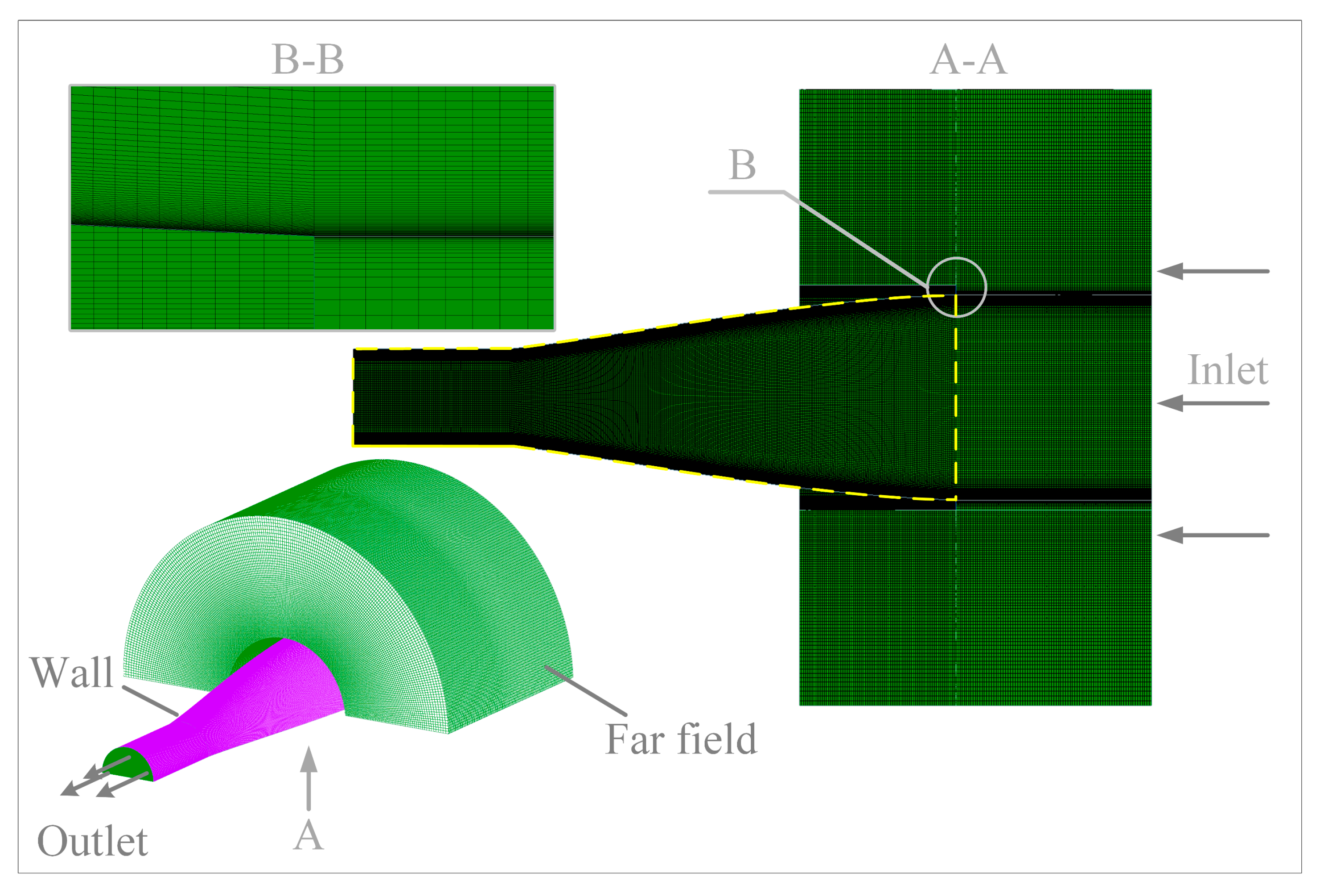

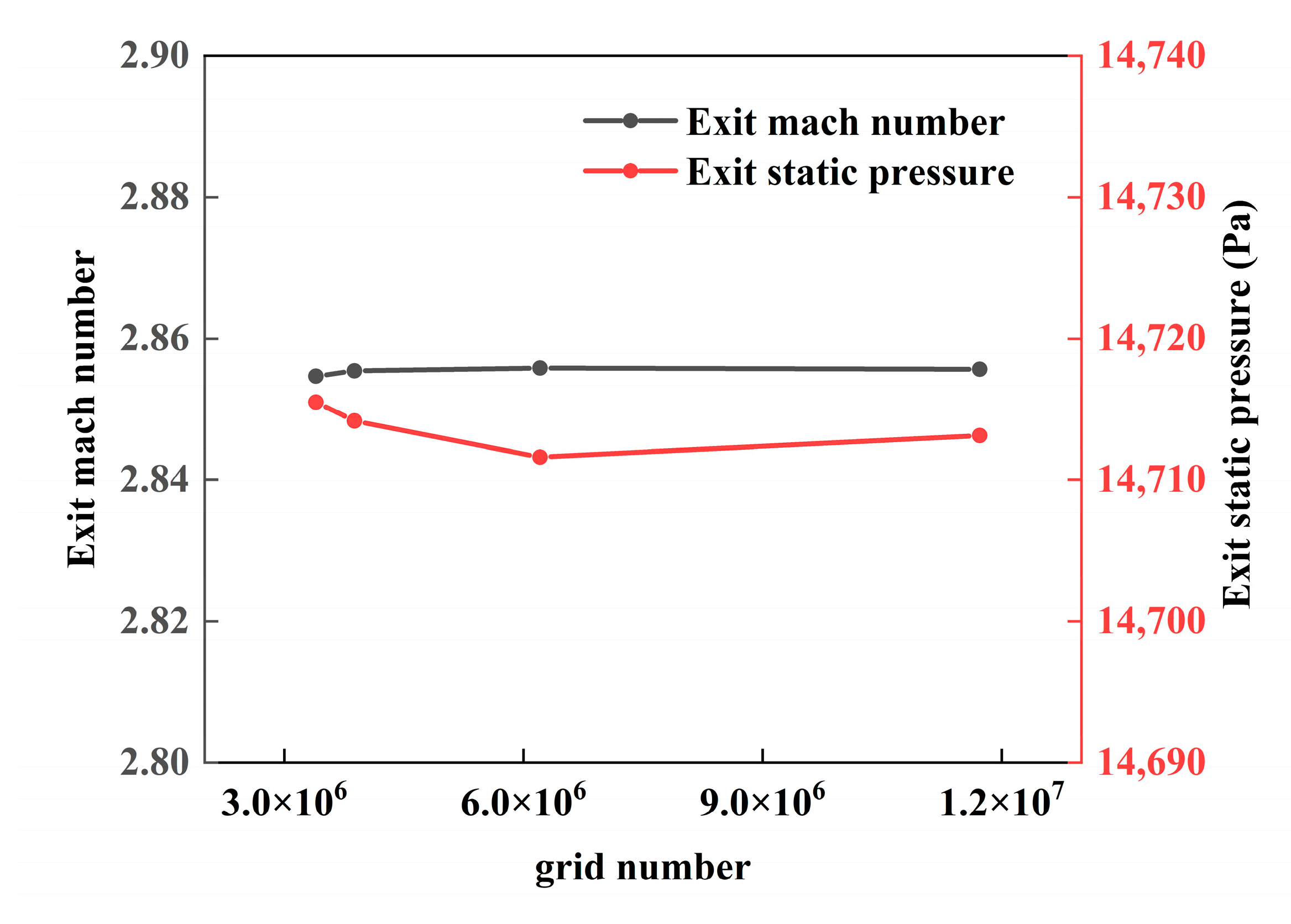

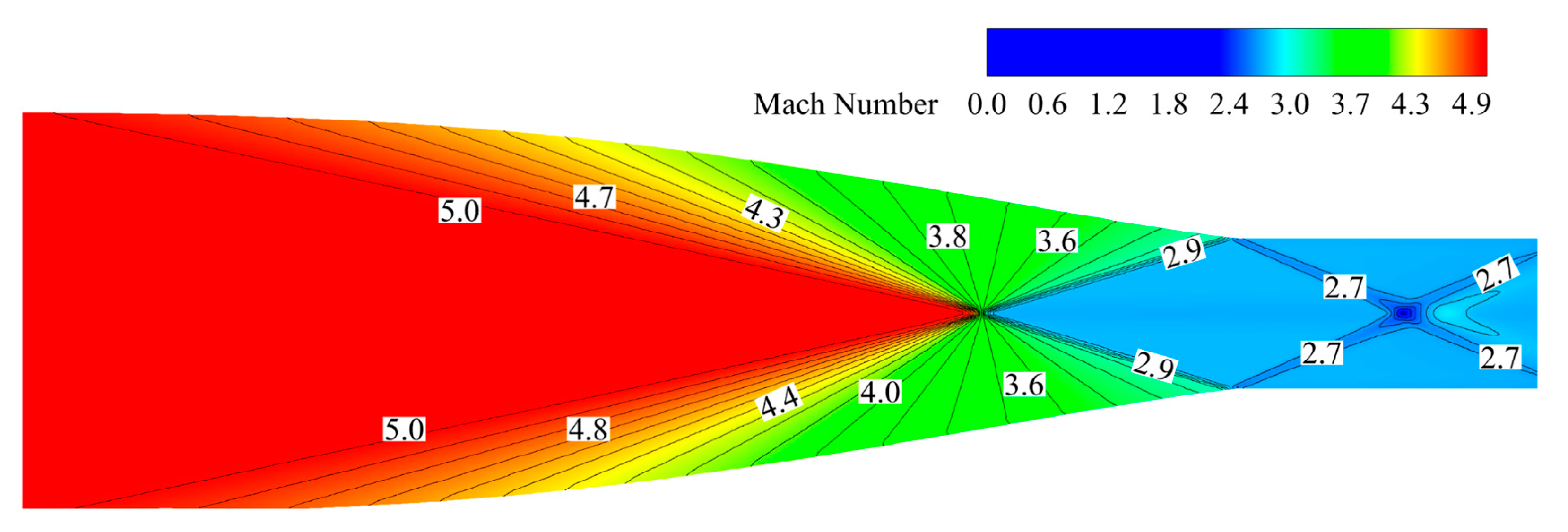

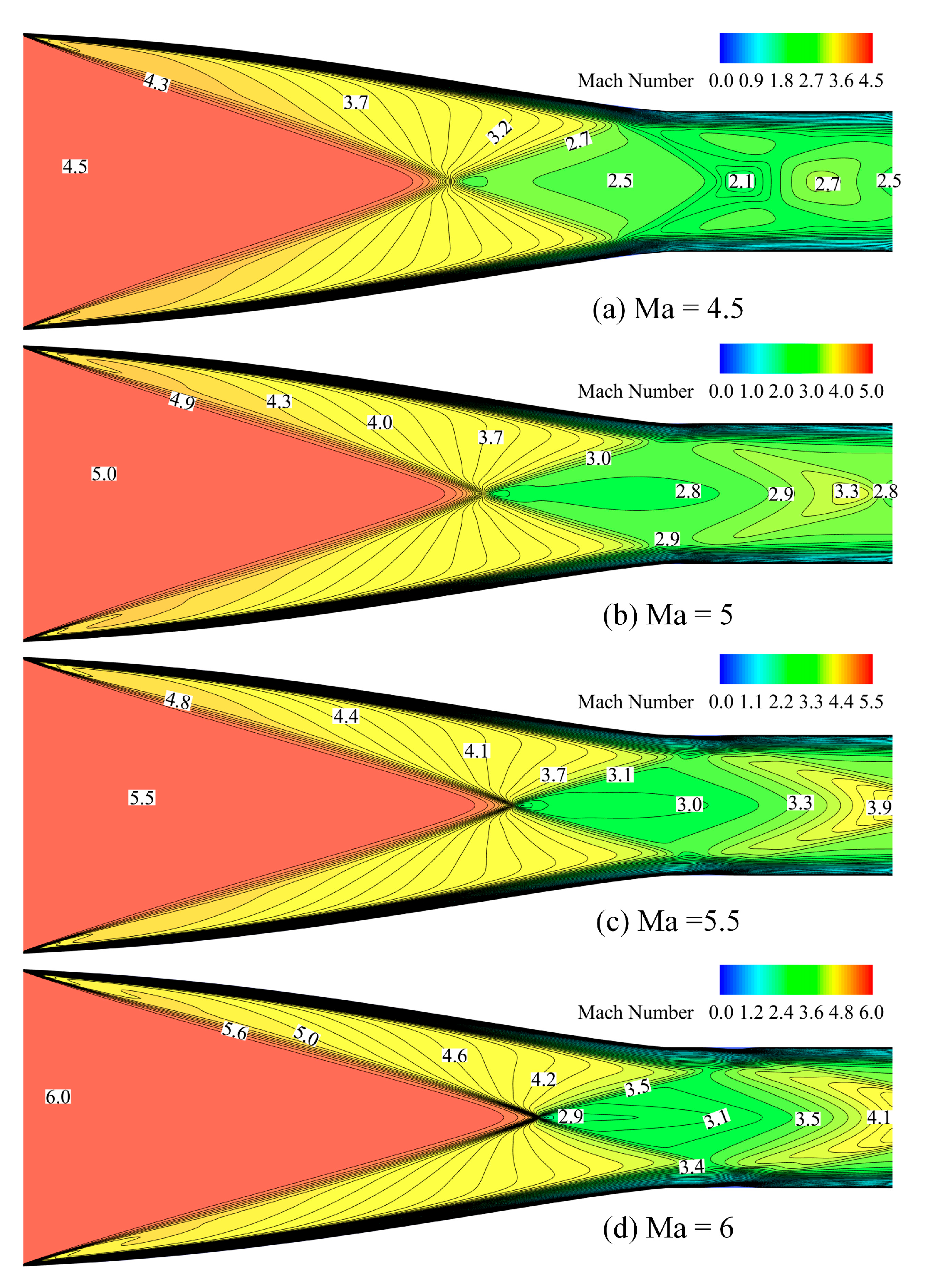
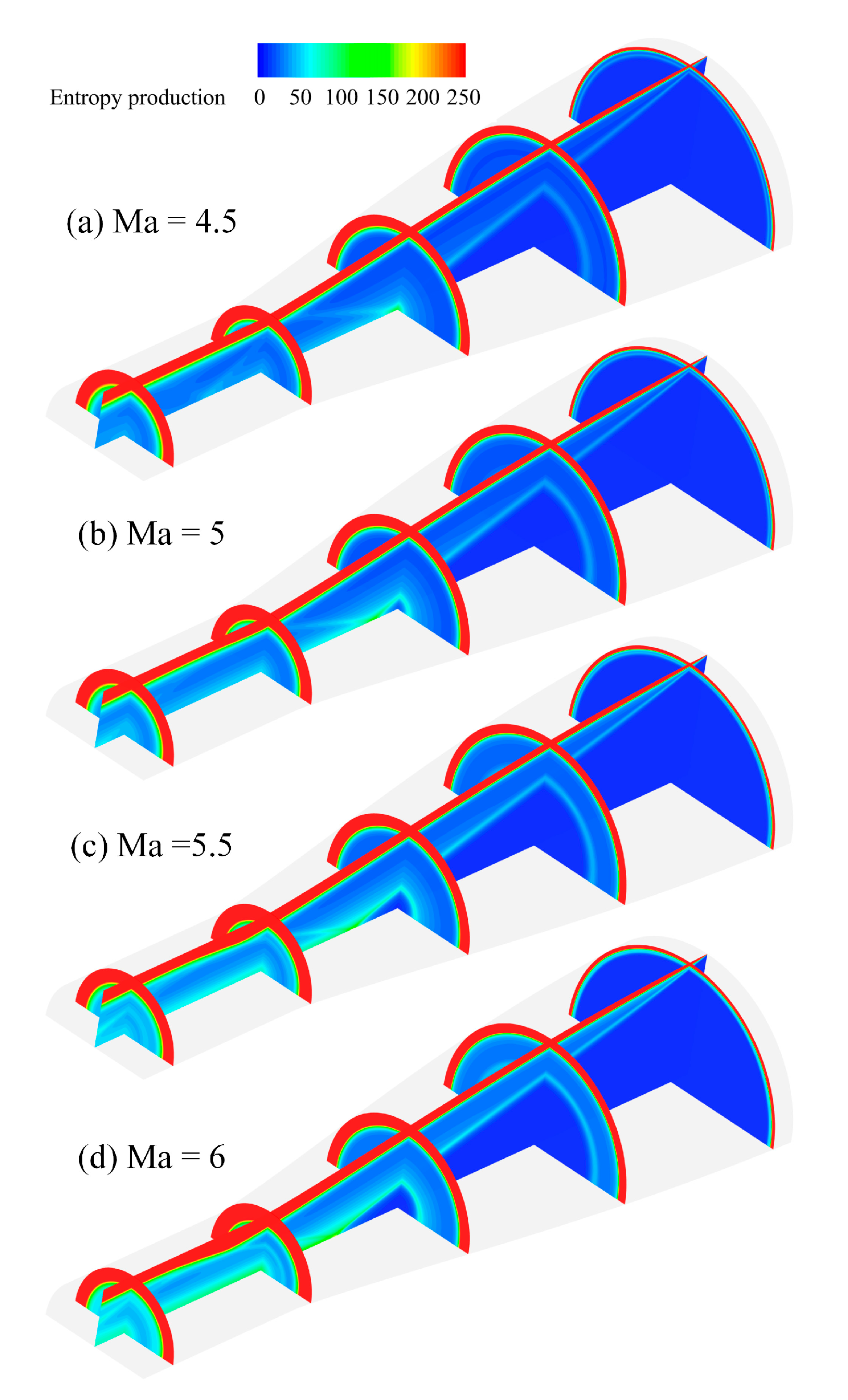
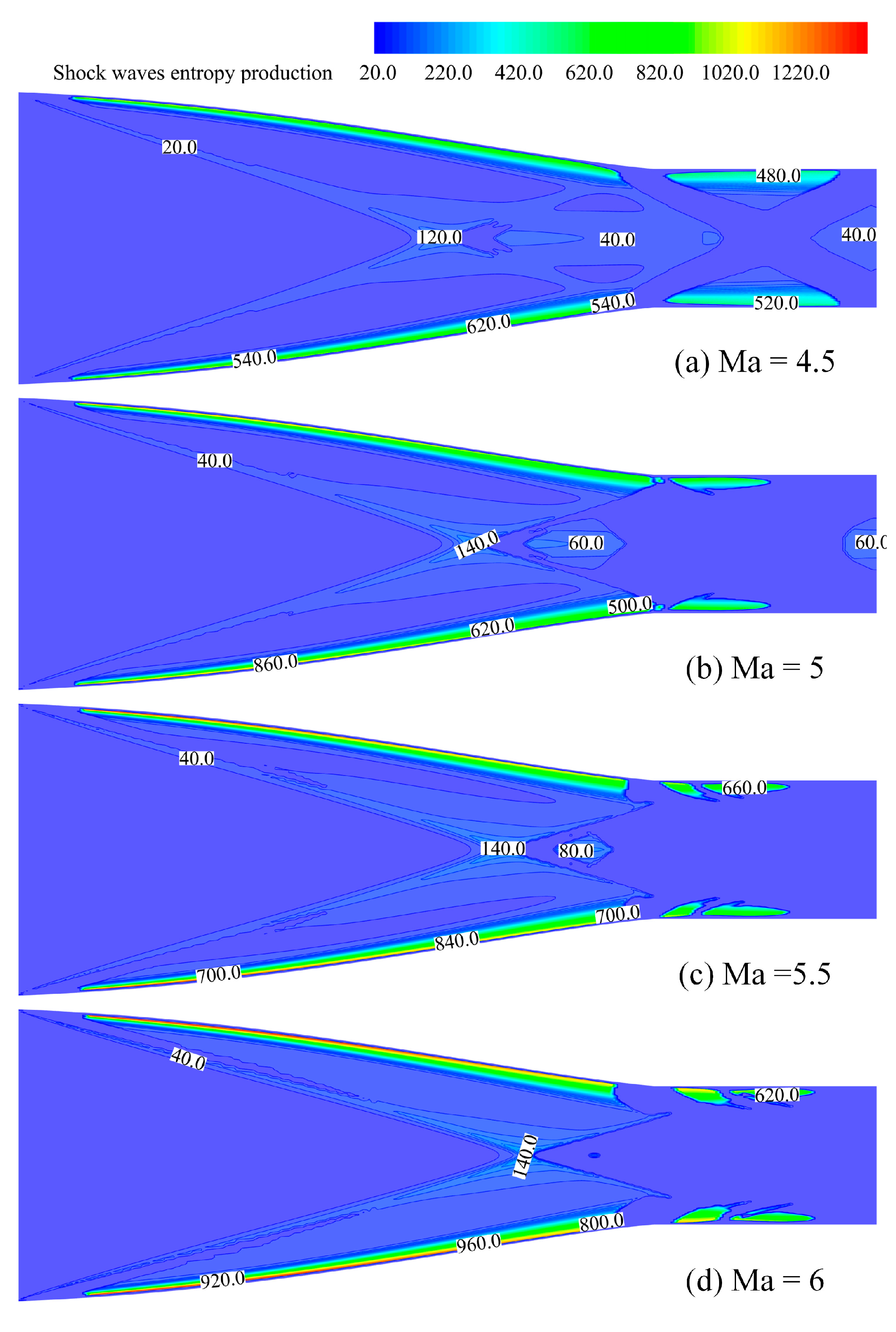
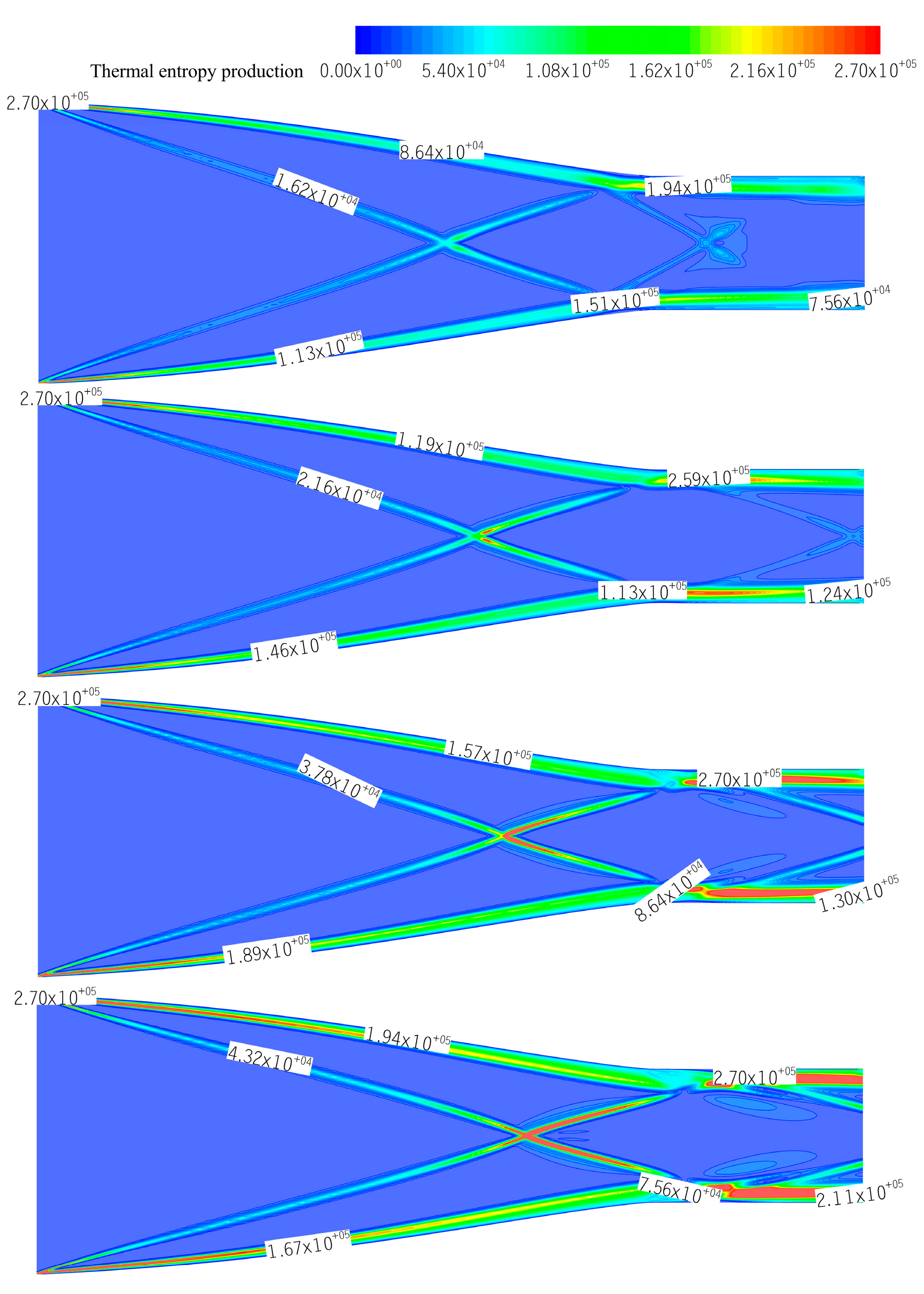
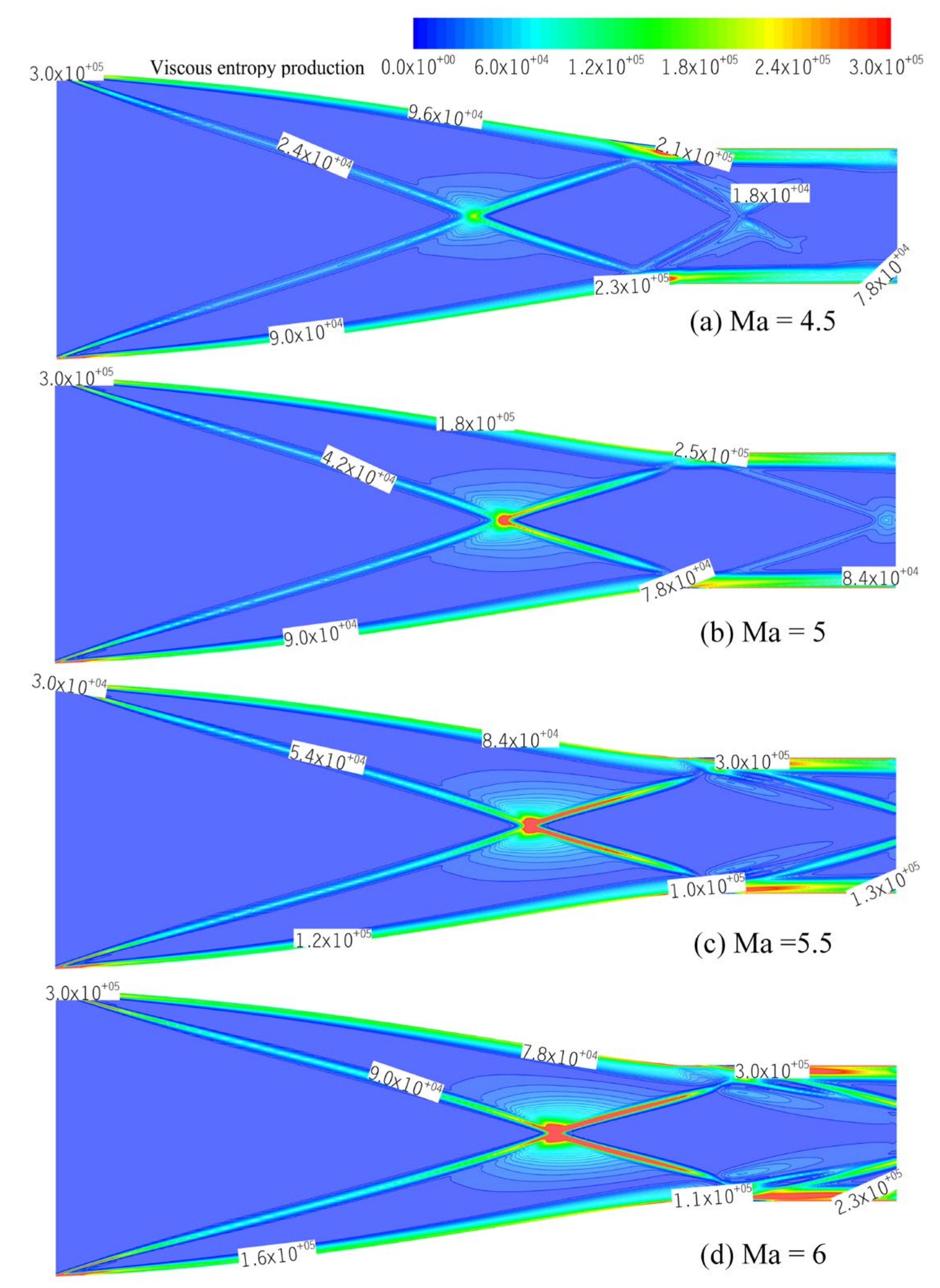
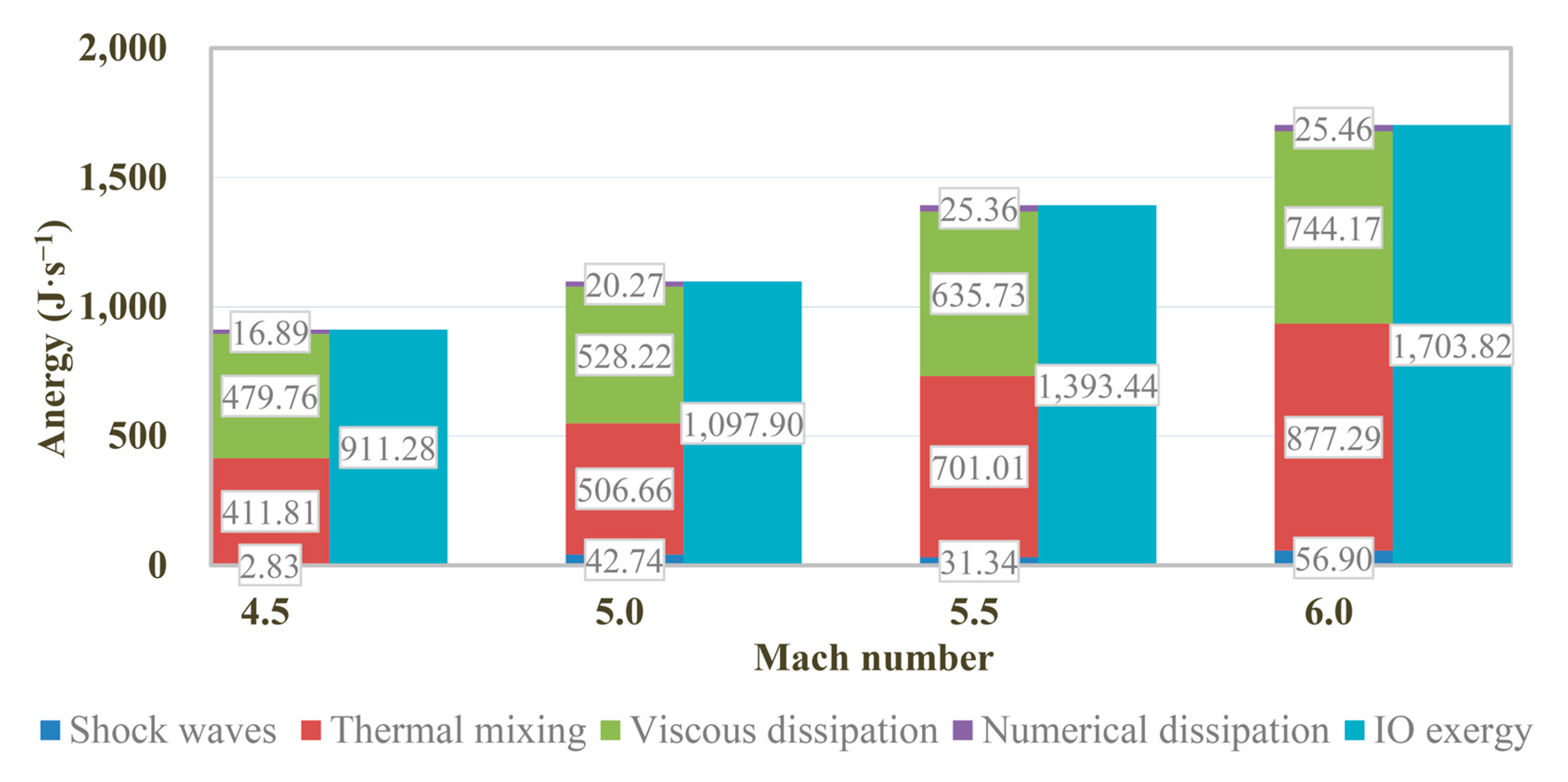

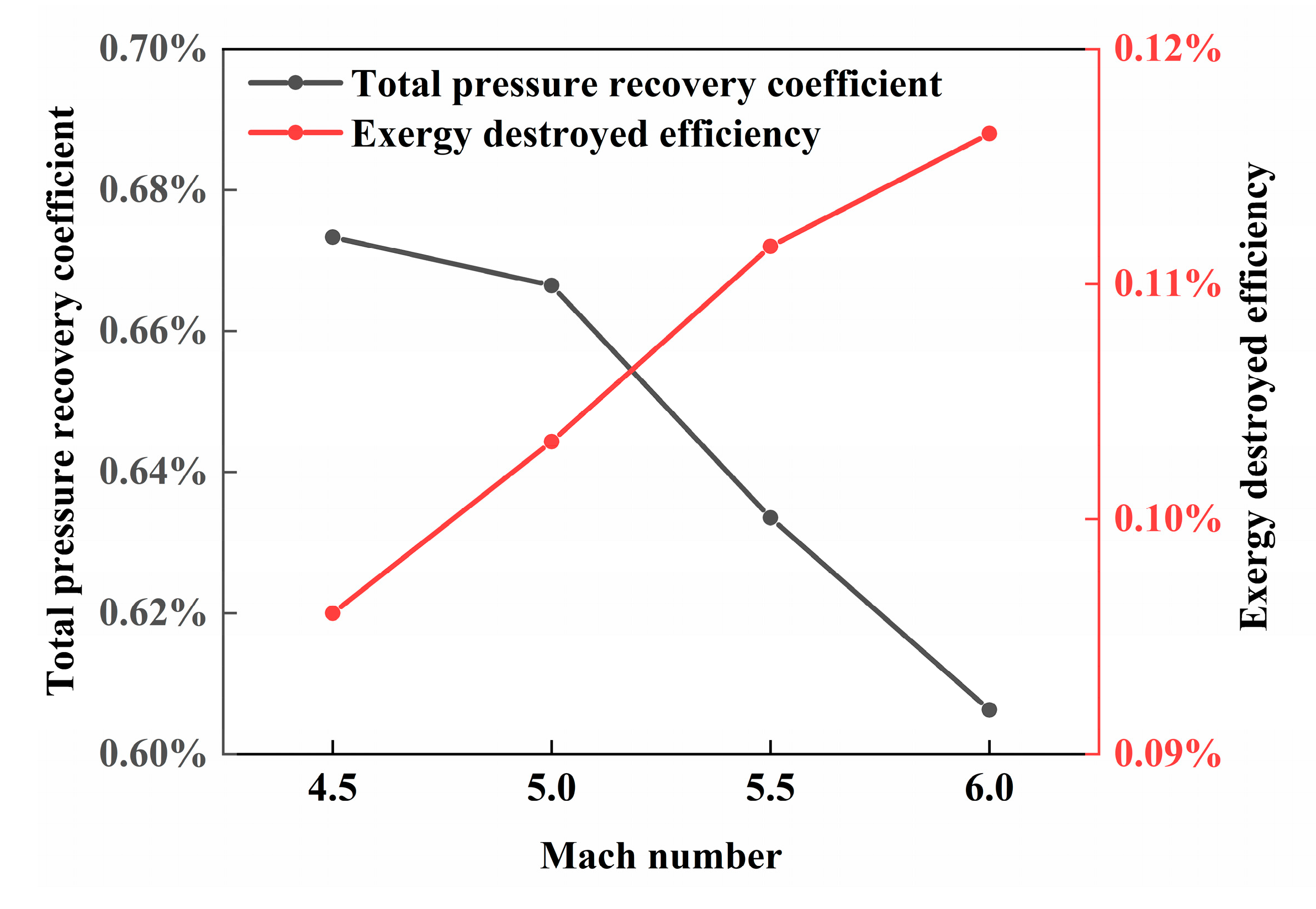

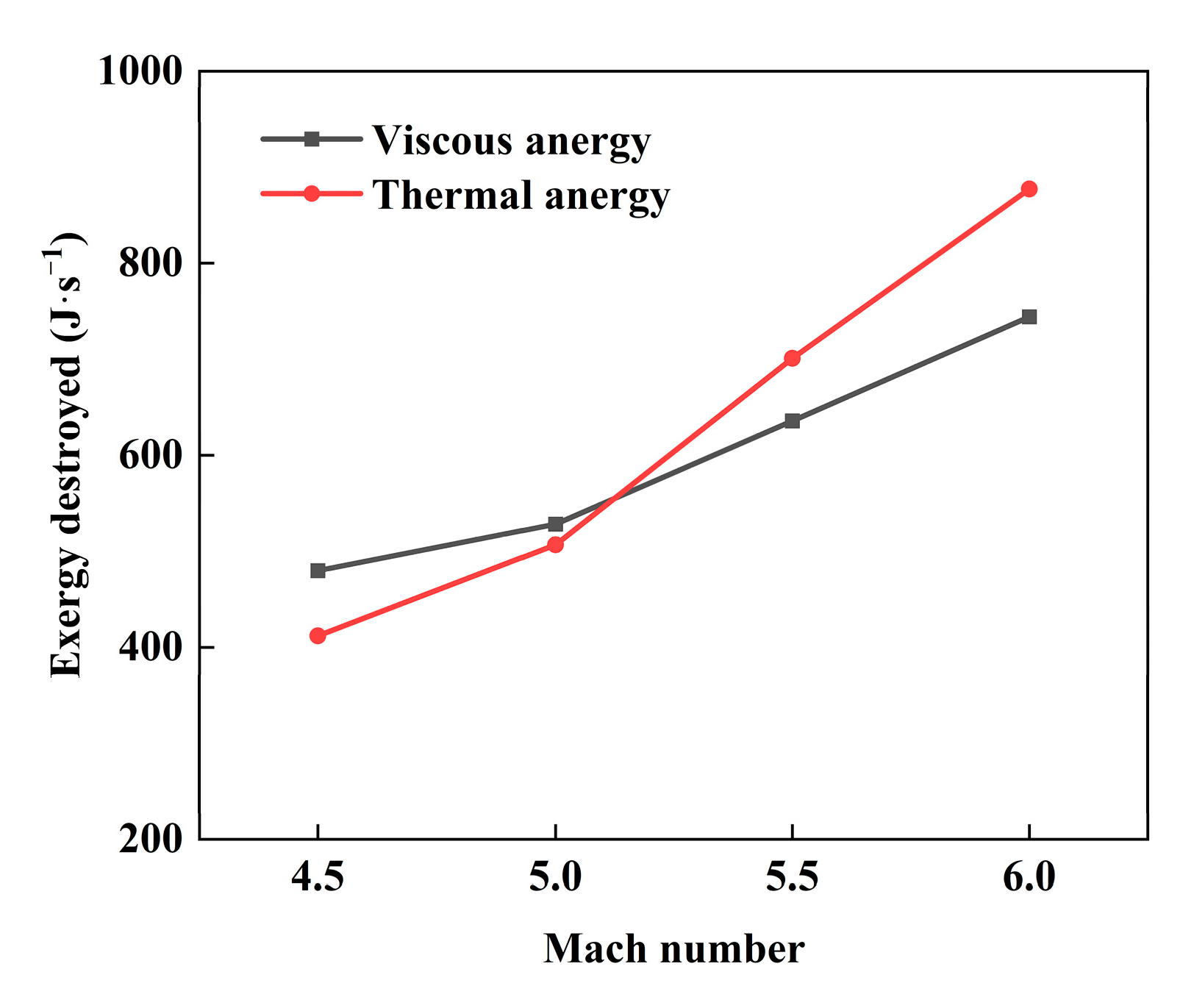
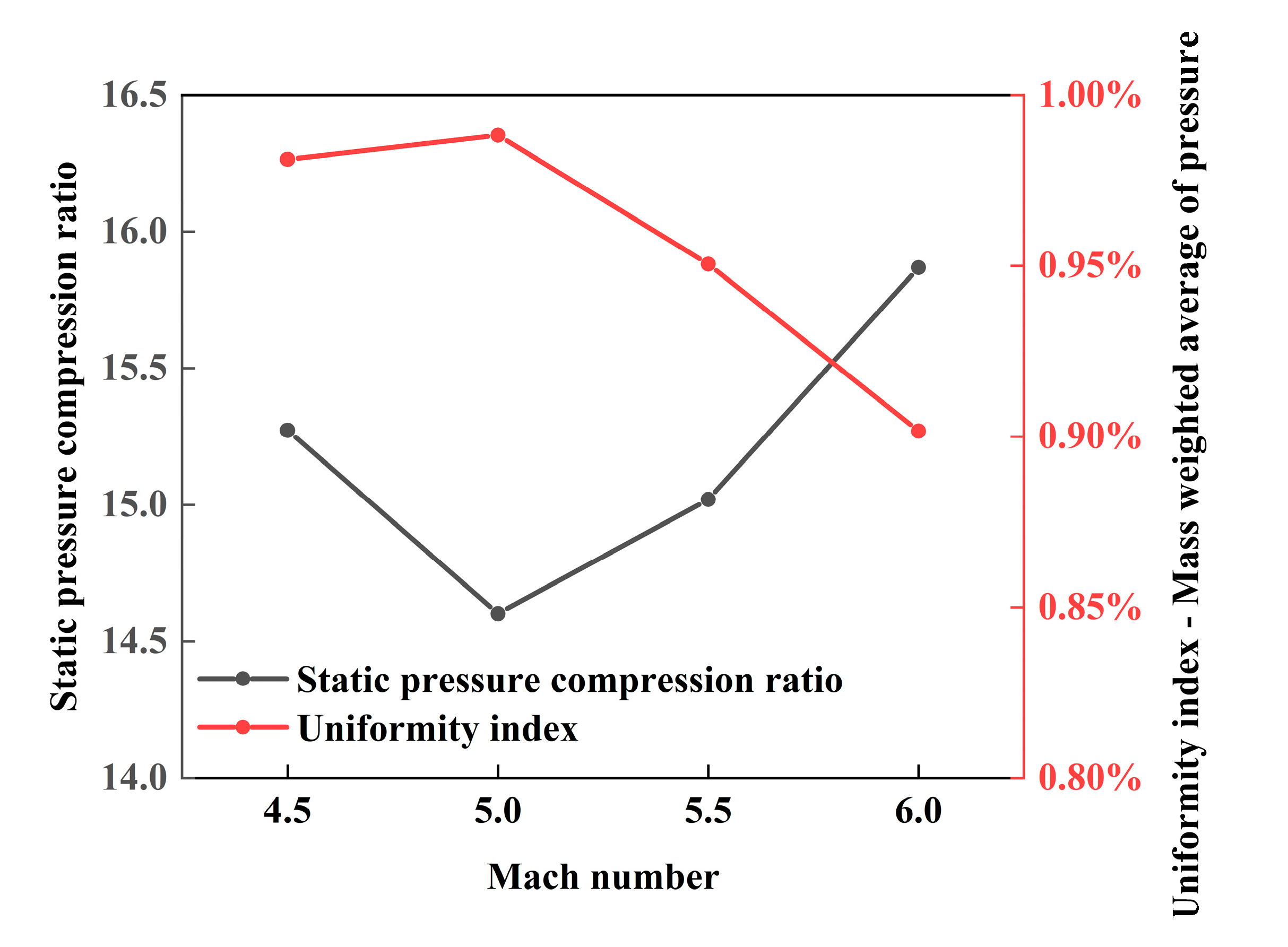

| Parameter | Symbol | Value | Unit |
|---|---|---|---|
| Freestream Mach number | 5 | − | |
| Throat Mach number | 3 | − | |
| Shape of exit | − | circle | − |
| Radius of exit | 10 | cm | |
| Ratio of specific heat | 1.4 | − | |
| Freestream pressure | 1170 | Pa | |
| Freestream temperature | 226.65 | K |
| Entropy Production Rate (J∙K−1) | Anergy Calculated from Entropy (J∙s−1) | Anergy Calculated from Balance Equations (J∙s−1) | Errors |
|---|---|---|---|
| 0.189 | 42.84 | 42.93 | 0.21% |
| Parameters | Inflow | Outflow | Difference Value |
|---|---|---|---|
| Streamwise kinetic exergy deposition rate, (J∙s−1) | 34,742.70 | 25,274.78 | −9467.92 |
| Transverse kinetic exergy deposition rate, (J∙s−1) | 0.0 | 2.42 | 2.42 |
| Boundary pressure work rate, (J∙s−1) | 0.01 | 4449.84 | 4449.83 |
| Rate of thermal exergy, (J∙s−1) | 1986.71 | 6959.45 | 4972.74 |
| Total (J∙s−1) | 36,729.42 | 36,686.49 | 42.93 |
Disclaimer/Publisher’s Note: The statements, opinions and data contained in all publications are solely those of the individual author(s) and contributor(s) and not of MDPI and/or the editor(s). MDPI and/or the editor(s) disclaim responsibility for any injury to people or property resulting from any ideas, methods, instructions or products referred to in the content. |
© 2024 by the authors. Licensee MDPI, Basel, Switzerland. This article is an open access article distributed under the terms and conditions of the Creative Commons Attribution (CC BY) license (https://creativecommons.org/licenses/by/4.0/).
Share and Cite
Zhu, M.; Zhou, S.; Liu, Y.; Li, Z.; Chen, Z. Control-Volume-Based Exergy Method of Truncated Busemann Inlets in Off-Design Conditions. Processes 2024, 12, 535. https://doi.org/10.3390/pr12030535
Zhu M, Zhou S, Liu Y, Li Z, Chen Z. Control-Volume-Based Exergy Method of Truncated Busemann Inlets in Off-Design Conditions. Processes. 2024; 12(3):535. https://doi.org/10.3390/pr12030535
Chicago/Turabian StyleZhu, Meijun, Shuai Zhou, Yang Liu, Zhehong Li, and Ziyun Chen. 2024. "Control-Volume-Based Exergy Method of Truncated Busemann Inlets in Off-Design Conditions" Processes 12, no. 3: 535. https://doi.org/10.3390/pr12030535






